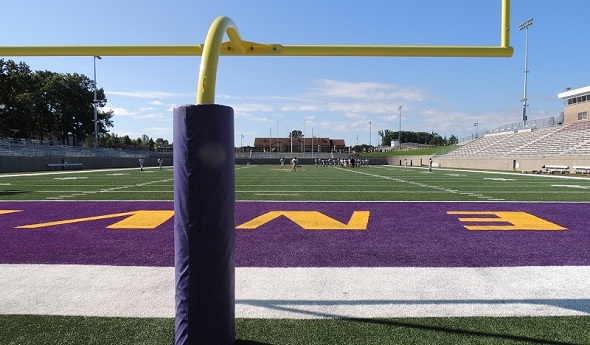
A Legacy Begins in Greenville
August 24, 2012
By Geoff Kimmerly
Second Half editor
GREENVILLE – Curtis Heppe has no idea what to expect, but a few guesses and a dream or two of how it will feel tonight to lead his teammates into Greenville's Legacy Field for the first time.
“It’s going to be electric, for sure. It’s a new vibe. It’s high-tech there,” the Yellow Jackets quarterback said Thursday after his team’s final preseason practice.
Those expectations are shared by a community that will be cheering on the local team in a new home after nearly a century at the legendary Black Field.
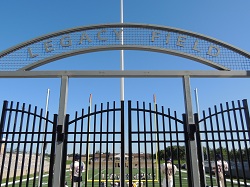 Workers put the finishing touches on the near-$7 million facility this week in advance of the season's first varsity game, tonight against rival Belding. Legacy Field officially opened for Wednesday’s freshman game, and Heppe said that even for that lower-level appetizer, the stadium began to come alive.
Workers put the finishing touches on the near-$7 million facility this week in advance of the season's first varsity game, tonight against rival Belding. Legacy Field officially opened for Wednesday’s freshman game, and Heppe said that even for that lower-level appetizer, the stadium began to come alive.
“We’ve just wanted Friday night to come. To get in and see how intense, how nice this place is,” he said. “Coming out of that tunnel, seeing our fans, it’s going to be the best feeling.”
Tonight’s grand opening will be the culmination of efforts from not just administrators, but students and community members as well – down to the name of the stadium itself.
“Legacy Field” was selected by Greenville’s school board. But it came as a suggestion from the school’s student council, which took submissions from classmates and then with faculty and administrators whittled the list to three favorites – Stinger Stadium and Community Field were next on their list.
But that’s just one way Legacy Field is a blend of old and new and ideas from all over town.
“In development, (it’s been) probably 10 years. We’ve been talking about it ever since I’ve been here, that one day we’d be able to do this,” said Greenville athletic director Brian Zdanowski, who is entering his 15th school year at that post. “It came through strategic planning. It came through community input. And then ultimately, our board bought in that there was enough interest in the community.”
Deeply rooted
A walk through Legacy Field is a history lesson. But first, an explanation of the Yellow Jackets’ past.
Black Field had served as the team’s home since 1916. It is nestled downtown next to Greenville’s former high school, which is now a library.
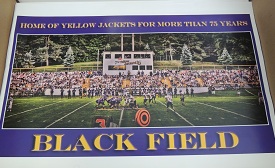 The current high school, about 1.5 miles northwest, was built in 1963. Football teams continued to make the short trip for home games.
The current high school, about 1.5 miles northwest, was built in 1963. Football teams continued to make the short trip for home games.
Black Field has its charms. With no track surrounding the field like at many multi-purpose stadiums, fans are only a few yards from the sideline. And all of that history added to the mystique for the latest players to wear the uniform.
The field also has had peculiarities. Zdanowski said at one point, the end zones were elevated in the corners. And the field wasn’t always square – a 10-yard penalty might measure 11 on one side of the field but only nine yards on the other.
But after just about every home game, students met for a bonfire on the grounds, an extension of the celebration by neighborhoods that surround Black Field and embraced the team for decades.
“It was the typical focal point of the community,” Zdanowski said.
Some things old, many new
Playing on Black Field was special, Heppe added. But he's equally if not more excited to be part of this new legacy. And architects made sure to bring that community feel to the new home this fall.
Destruction and construction began May 2, the day after last season’s final girls tennis match. The courts formerly sat in what is near the south end zone, and were moved closer to the track and soccer facility.
Amenities at the Yellow Jackets’ new football home are comparable to a college stadium’s, starting at the north side of the field.
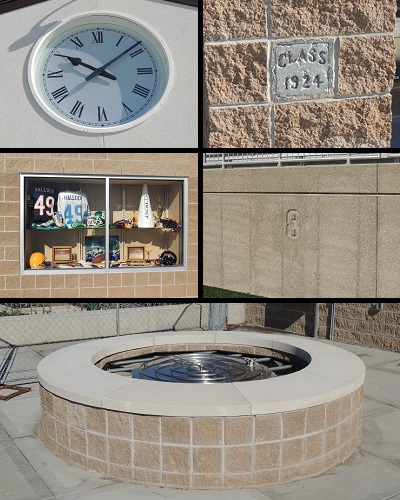 Players will enterthrough a tunnel that pours into the field like that of a miniature Spartan Stadium. Surrounding the tunnel are expansive locker rooms both for the home team and visitors, a similarly expansive training room and officials area and plenty of storage that will allow Greenville’s entire football program to be housed under that one roof. Unlike Black Field, tucked neatly among its neighbors, Legacy Field has plenty of parking and lighting, and builders were able to make that possible while also keeping intact a group of large oak trees near the south gate.
Players will enterthrough a tunnel that pours into the field like that of a miniature Spartan Stadium. Surrounding the tunnel are expansive locker rooms both for the home team and visitors, a similarly expansive training room and officials area and plenty of storage that will allow Greenville’s entire football program to be housed under that one roof. Unlike Black Field, tucked neatly among its neighbors, Legacy Field has plenty of parking and lighting, and builders were able to make that possible while also keeping intact a group of large oak trees near the south gate.
The turf is synthetic, like that played on by all but one member of the Yellow Jacket’s O-K Bronze conference. The difference from many is that the field has been dug out from the surrounding property, making it even more a focal point for those who will occupy the roughly 4,000 seats in the surrounding cement bowl. (The removed dirt was used to build two Little League fields on another part of the property.)
The sound system is of course state-of-the-art, and the press box, concessions area and restrooms also are equally expansive. But what locals should notice most are the throwbacks to the past that dot every corner of their new home.
Cut into the brick work near the concession counter is a block from Black Field that had been dedicated by the school’s class of 1924. Atop the building is the Centennial Clock, 100 years old this year, which formerly hung at the entrance the old school and was donated by the class of 1912. It has been housed by Greenville’s museum until being re-donated to the school district to become part of the stadium.
Molded into the cement walls on the west and south sides of the field are the numbers formerly worn by players Henry Loding and Greg Blumberg. Both died from football-related injuries; Loding in 1906 and Blumberg in 1977. Two trophy cases are cut into the stone on the facing of the press box, including one featuring mementos celebrating alum and former Detroit Lions tight end Ty Hallock.
Another addition of historical significance will come later. The school’s first Hall of Fame class will be inducted before the Sept. 7 game, and that display will be housed near the south ticket area so residents and fans can check it out without having the enter the stadium itself.
And one last thing was added to keep with tradition. To the west of the concession area, but within the stadium fence, sits a large gas fire pit for those postgame gatherings – plus a sound system where students can plug in their mp3 players.
“We said we’re not forgetting our past, but we’re embracing our future,” Zdanowski said. “I’m sure a lot of people have said that before. So we really wanted to make sure we got community input on it and do as much as we could to replicate Black Field. … And I think we won some people over. We really wanted to do what we said (we’d do).”
PHOTOS: (Top) Greenville's junior varsity ran through drills during a morning session at Legacy Stadium, which opened this week. (Top middle) The ticket area and gate for fans sit on the south side of the field. (Middle) A poster given out last season celebrated the final to be played at Black Field. (Bottom middle) A number of pieces of Black Field's past and Greenville tradition were brought over to or included in Legacy Field, including Centennial Clock, which formerly was part of the old school.
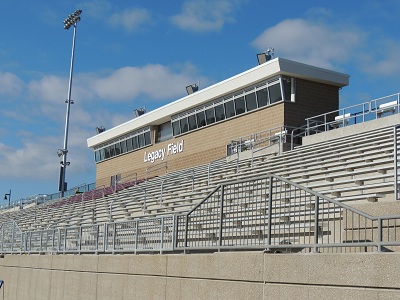
Legacy Field's press box is split into areas for game workers, coaches and media with a roll-up door for film crews.
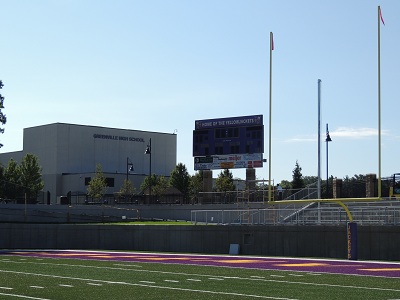
Legacy Field sits between Greenville's high school and middle school and adjacent to its soccer and track facilities.
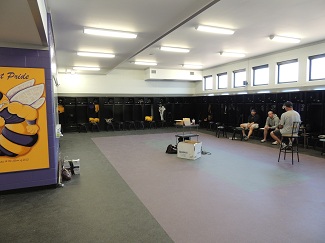
Coaches met in the spacious varsity locker room Monday morning. Junior varsity and freshman locker rooms are connected by a hallway with access to storage areas and the coaches' office.
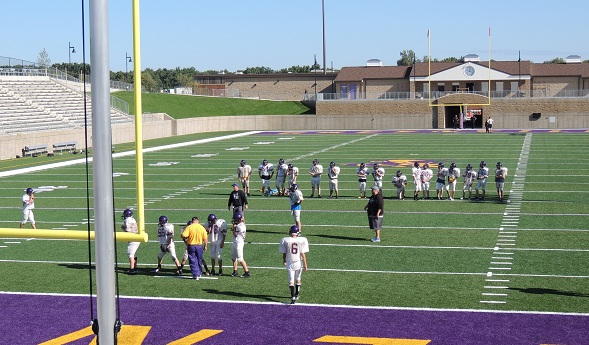 Players will enter Legacy Field through a tunnel at its north end. Above sits the concession area and restrooms, and the Centennial Clock that once ticked in the old Greenville school.
Players will enter Legacy Field through a tunnel at its north end. Above sits the concession area and restrooms, and the Centennial Clock that once ticked in the old Greenville school.
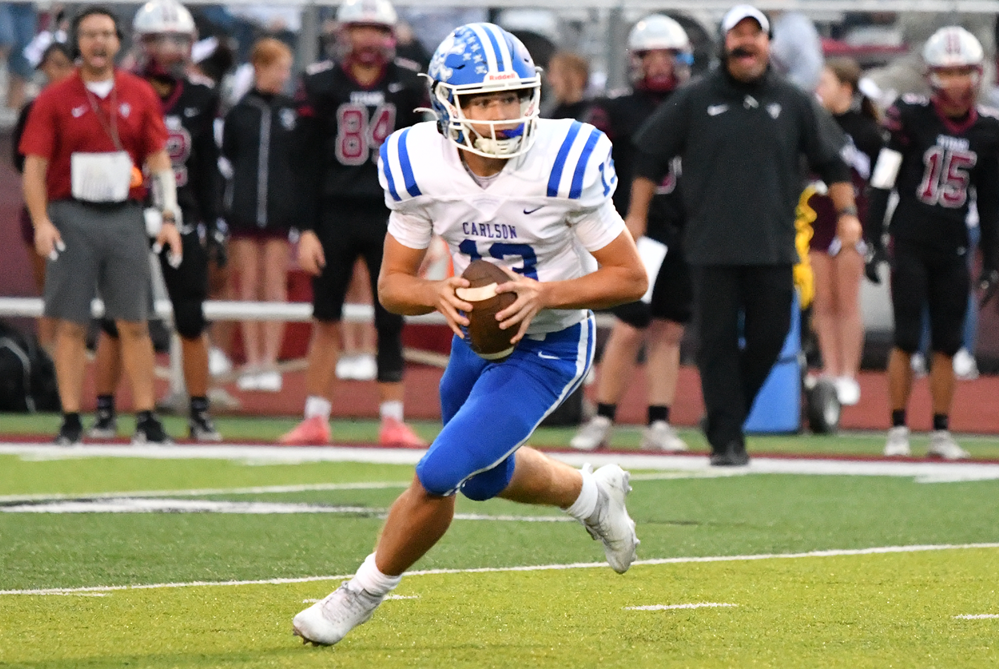
Carlson's 'Power-Spread' Piling Up Points Despite Missing Leading Rusher
By
Doug Donnelly
Special for MHSAA.com
October 2, 2024
In Johnny Cash’s song “One Piece at a Time,” the main character collects car parts over the years to build a one-of-a-kind automobile.
 At the end of the song, he’s asked what model it is. That’s where he runs into trouble.
At the end of the song, he’s asked what model it is. That’s where he runs into trouble.
“Well, it’s a ’49, ’50, ’51, ’52 …” Cash sings.
That automobile is a lot like the offense that has Gibraltar Carlson’s football team off to a 5-0 start.
“We pride ourselves in running the football here,” third-year head coach Jason Gendron said. “That is our identity. We play power football.”
That’s not the full story, however.
“We are multi-set, really,” Gendron said. “We have Wing-T principles, but we are a spread, Wing-T team that can go tight formations with two tight ends and three running backs. We also can go spread and run some run-pass option things. We also like to run counter off that.
“At the end of the day, power football is where we like to be. We can run that out of multiple sets. Everything we do is based off power.”
Marauders quarterback Joe Krolak agrees. Sort of.
“It’s power-spread,” Krolak said. “It’s hard to describe. We can go under center, or we can go spread.”
No matter what you call it, the Marauders’ offense is clicking in all gears. Carlson is averaging a two-point conversion shy of 50 points a game in their 5-0 start.
That Carlson is having success is not surprising or anything new. The Marauders have won four straight Downriver League championships and have made the playoffs seven years running. The surprising piece this season is they have done it without Division I college recruit Izaiah Wright, the junior running back who rushed for 1,965 yards and 31 touchdowns as a sophomore in leading Carlson to a 10-2 record.
Wright played in Week 1. But on the first offensive series of the game in Week 2, he went down with an ankle injury and hasn’t played since.
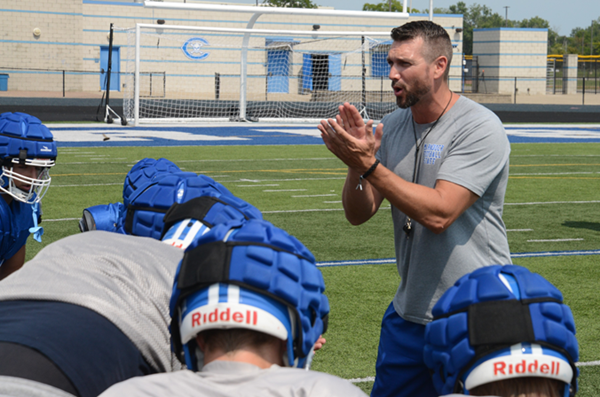 “It’s been a slow recovery,” Gendron said. “He’s been week-to-week. He’s getting closer. I do think he’ll play again this year, but I don’t know if he will be 100 percent this year.”
“It’s been a slow recovery,” Gendron said. “He’s been week-to-week. He’s getting closer. I do think he’ll play again this year, but I don’t know if he will be 100 percent this year.”
In his place, the Marauders were sharing carries among multiple backs until last week when junior Avery Ortiz got the full workload. He responded with 200 yards rushing and multiple touchdowns.
Gendron said he and the Carlson coaches saw the potential in Ortiz.
“Avery has been the running back who has emerged,” Gendron said. “We feel Avery is one of the best backs in our conference and southeast Michigan.”
Ortiz has been Wright’s backup for a couple of seasons. Last year Gendron asked Ortiz about changing positions to get him on the field, and he started playing safety. This season, with Wright out, Ortiz found himself on the offensive side of the ball again.
“He has great vision and is really good on his cuts,” Gendron said. “Avery is a running back at heart. He’s always wanted to be the running back here, but you have a kid in front of him who is a Division I player who beat him out. That’s just the way it goes. At least he was humble enough to accept that and find another place to play. For him to get that back, seize the moment and run with it, is the credit to the type of kid he is.”
Krolak said the offense hasn’t skipped a beat with Ortiz as the featured back.
“Everybody knows in this program it’s next man up,” Krolak said. “We have a lot of athletes in this program who can do the same things he can do. Avery has really stepped up big. He’s looking phenomenal. He’s a great running back and has carried us through this.”
Gendron called Krolak the team’s first-half MVP. Krolak has completed 44 of 62 passes for 669 yards and six touchdowns and rushed for another 406 yards and nine touchdowns.
“Joe is a very dangerous runner and has gotten better at throwing,” Gendron said. “He’s a dual-threat quarterback. You can’t just key on Izaiah or Avery. You have to have eyes on Joe. He’s been the player of the year for us without question. He’s leading us and doing everything I’ve asked him to do at the position. He’s having a great year.”
Krolak, a senior, said he was ready for his number to be called more with Wright out.
“I knew I would get the ball more,” Krolak said. “Coach told me I was going to run the ball more and throw it around, and I was completely ready for it.”
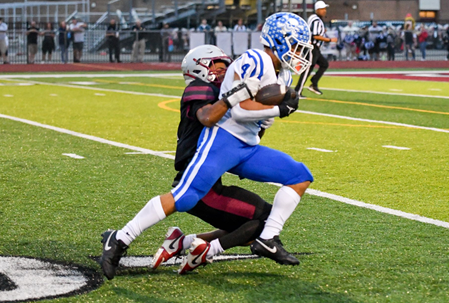 Carlson has several more weapons, including tight end Drew Sikora and receivers Brendan Stanley and Landon Vida. Everything starts up front, however.
Carlson has several more weapons, including tight end Drew Sikora and receivers Brendan Stanley and Landon Vida. Everything starts up front, however.
“I tell our offensive line that they are the most important position group on the field, both our offensive and defensive lines,” Gendron said. “They have bought in and embraced that and the fact that we want to be a power, smash-mouth football team.”
Carlson’s been pretty good on defense, too, giving up just six touchdowns all season.
Gendron is a Monroe Jefferson graduate who played for Marc Cisco, who retired after 47 years coaching the Bears. That’s where Gendron learned the fundamentals of the game and about power football.
“It works,” Gendron said. “It worked back then for Marc, and it works for us. It’s good football. I believe in it. The kids buy into it. There’s nothing better from an offensive standpoint when you can get three yards at will and you can call the play again and it works.”
The current offense is a mix of Gendron’s years playing at Jefferson and schematic strategies incorporated by Dan Kalbfleisch, the Carlson athletic director and assistant football coach.
“We’ve blended Dan’s experience with his spread concepts and the things I value about offensive football – the ground and pound, power football concepts – into one offense. Dan brings the pre-snap, tempo, no-huddle offense with motion and getting guys into space. That’s what you see. We both believe in running the football.”
Carlson has some tough games ahead, but Gendron is pleased with how the season is shaping up. With a little luck, they might get Wright back in time for a playoff run.
“We are on schedule right now,” he said. “Our guys have done what they need to do at this point. We take things one week at a time. Trenton is on the clock right now.”
 Doug Donnelly has served as a sports and news reporter and city editor over 25 years, writing for the Daily Chief-Union in Upper Sandusky, Ohio from 1992-1995, the Monroe Evening News from 1995-2012 and the Adrian Daily Telegram since 2013. He's also written a book on high school basketball in Monroe County and compiles record books for various schools in southeast Michigan. E-mail him at [email protected] with story ideas for Jackson, Washtenaw, Hillsdale, Lenawee and Monroe counties.
Doug Donnelly has served as a sports and news reporter and city editor over 25 years, writing for the Daily Chief-Union in Upper Sandusky, Ohio from 1992-1995, the Monroe Evening News from 1995-2012 and the Adrian Daily Telegram since 2013. He's also written a book on high school basketball in Monroe County and compiles record books for various schools in southeast Michigan. E-mail him at [email protected] with story ideas for Jackson, Washtenaw, Hillsdale, Lenawee and Monroe counties.
PHOTOS (Top) Gibraltar Carlson quarterback Joe Krolak considers his best option during last week’s win over Southgate Anderson. (Middle) Carlson coach Jason Gendron pumps up his team during a practice. (Below) The Marauders’ Avery Ortiz drags a defender downfield. (Game photos by Kim Britt; practice photo by Niles Kruger/Monroe News.)

